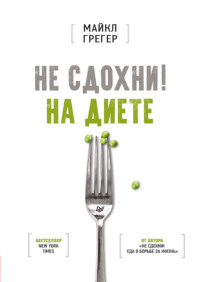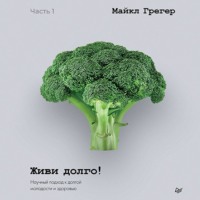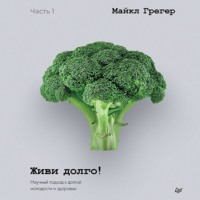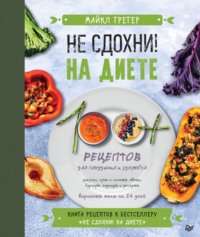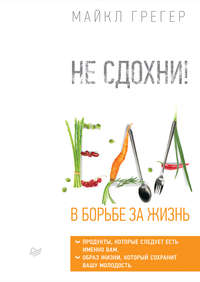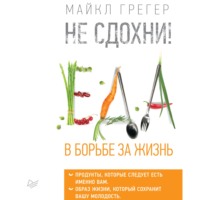
Полная версия
Живи долго! Научный подход к долгой молодости и здоровью
1826
Zhao L, Cao J, Hu K, et al. Sirtuins and their biological relevance in aging and age-related diseases. Aging Dis. 2020;11(4):927–45. https://www.ncbi.nlm.nih.gov/pmc/articles/PMC7390530/
1827
Satoh A, Brace CS, Rensing N, et al. Sirt1 extends life span and delays aging in mice through the regulation of Nk2 homeobox 1 in the DMH and LH. Cell Metab. 2013;18(3):416–30. https://pubmed.ncbi.nlm.nih.gov/24011076/
1828
Kanfi Y, Naiman S, Amir G, et al. The sirtuin SIRT6 regulates lifespan in male mice. Nature. 2012;483(7388):218–21. https://pubmed.ncbi.nlm.nih.gov/22367546/
1829
Brenner C. Sirtuins are not conserved longevity genes. Life Metabolism. Published online September 22, 2022. https://academic.oup.com/lifemeta/advance-article/doi/10.1093/lifemeta/loac025/6711379. Accessed December 27, 2022.; https://academic.oup.com/lifemeta/article/1/2/122/6711379
1830
Giblin W, Skinner ME, Lombard DB. Sirtuins: guardians of mammalian healthspan. Trends Genet. 2014;30(7):271–86. https://pubmed.ncbi.nlm.nih.gov/24877878/
1831
Wang RH, Sengupta K, Li C, et al. Impaired DNA damage response, genome instability, and tumorigenesis in SIRT1 mutant mice. Cancer Cell. 2008;14(4):312–23. https://pubmed.ncbi.nlm.nih.gov/18835033/
1832
Lee SH, Lee JH, Lee HY, Min KJ. Sirtuin signaling in cellular senescence and aging. BMB Rep. 2019;52(1):24–34. https://www.ncbi.nlm.nih.gov/pmc/articles/PMC6386230/
1833
Watroba M, Szukiewicz D. The role of sirtuins in aging and age-related diseases. Adv Med Sci. 2016;61(1):52–62. https://pubmed.ncbi.nlm.nih.gov/26521204/
1834
Palacios JA, Herranz D, De Bonis ML, Velasco S, Serrano M, Blasco MA. SIRT1 contributes to telomere maintenance and augments global homologous recombination. J Cell Biol. 2010;191(7):1299–313. https://www.ncbi.nlm.nih.gov/pmc/articles/PMC3010065/
1835
Morris BJ. Seven sirtuins for seven deadly diseases of aging. Free Radic Biol Med. 2013;56:133–71. https://pubmed.ncbi.nlm.nih.gov/23104101/
1836
Giblin W, Skinner ME, Lombard DB. Sirtuins: guardians of mammalian healthspan. Trends Genet. 2014;30(7):271–86. https://pubmed.ncbi.nlm.nih.gov/24877878/
1837
Flachsbart F, Croucher PJP, Nikolaus S, et al. Sirtuin 1 (SIRT1) sequence variation is not associated with exceptional human longevity. Exp Gerontol. 2006;41(1):98–102. https://pubmed.ncbi.nlm.nih.gov/16257164/
1838
Houtkooper RH, Pirinen E, Auwerx J. Sirtuins as regulators of metabolism and healthspan. Nat Rev Mol Cell Biol. 2012;13(4):225–38. https://pubmed.ncbi.nlm.nih.gov/22395773/
1839
Cantó C, Gerhart-Hines Z, Feige JN, et al. AMPK regulates energy expenditure by modulating NAD+ metabolism and SIRT1 activity. Nature. 2009;458(7241):1056–60. https://pubmed.ncbi.nlm.nih.gov/19262508/
1840
Xu W, Deng YY, Yang L, et al. Metformin ameliorates the proinflammatory state in patients with carotid artery atherosclerosis through sirtuin 1 induction. Transl Res. 2015;166(5):451–8. https://pubmed.ncbi.nlm.nih.gov/26141671/
1841
Dang W. The controversial world of sirtuins. Drug Discov Today Technol. 2014;12:e9–17. https://pubmed.ncbi.nlm.nih.gov/25027380/
1842
Guerra B, Guadalupe-Grau A, Fuentes T, et al. SIRT1, AMP-activated protein kinase phosphorylation and downstream kinases in response to a single bout of sprint exercise: influence of glucose ingestion. Eur J Appl Physiol. 2010;109(4):731–43. https://pubmed.ncbi.nlm.nih.gov/20217115/
1843
Guerra B, Guadalupe-Grau A, Fuentes T, et al. SIRT1, AMP-activated protein kinase phosphorylation and downstream kinases in response to a single bout of sprint exercise: influence of glucose ingestion. Eur J Appl Physiol. 2010;109(4):731–43. https://pubmed.ncbi.nlm.nih.gov/20217115/
1844
Asghari S, Asghari-Jafarabadi M, Somi MH, Ghavami SM, Rafraf M. Comparison of calorie-restricted diet and resveratrol supplementation on anthropometric indices, metabolic parameters, and serum sirtuin-1 levels in patients with nonalcoholic fatty liver disease: a randomized controlled clinical trial. J Am Coll Nutr. 2018;37(3):223–33. https://pubmed.ncbi.nlm.nih.gov/29313746/
1845
Crujeiras AB, Parra D, Goyenechea E, Martínez JA. Sirtuin gene expression in human mononuclear cells is modulated by caloric restriction. Eur J Clin Invest. 2008;38(9):672–8. https://pubmed.ncbi.nlm.nih.gov/18837744/
1846
Draznin B, Wang C, Adochio R, Leitner JW, Cornier MA. Effect of dietary macronutrient composition on AMPK and SIRT1 expression and activity in human skeletal muscle. Horm Metab Res. 2012;44(9):650–5. https://pubmed.ncbi.nlm.nih.gov/22674476/
1847
Lilja S, Stoll C, Krammer U, et al. Five days periodic fasting elevates levels of longevity related Christensenella and sirtuin expression in humans. Int J Mol Sci. 2021;22(5):2331. https://pubmed.ncbi.nlm.nih.gov/33652686/
1848
Heilbronn LK, Civitarese AE, Bogacka I, Smith SR, Hulver M, Ravussin E. Glucose tolerance and skeletal muscle gene expression in response to alternate day fasting. Obes Res. 2005;13(3):574–81. https://pubmed.ncbi.nlm.nih.gov/15833943/
1849
Mansur AP, Roggerio A, Goes MFS, et al. Serum concentrations and gene expression of sirtuin 1 in healthy and slightly overweight subjects after caloric restriction or resveratrol supplementation: a randomized trial. Int J Cardiol. 2017;227:788–94. https://pubmed.ncbi.nlm.nih.gov/28029409/
1850
Civitarese AE, Carling S, Heilbronn LK, et al. Calorie restriction increases muscle mitochondrial biogenesis in healthy humans. PLoS Med. 2007;4(3):e76. https://pubmed.ncbi.nlm.nih.gov/17341128/
1851
Cantó C, Gerhart-Hines Z, Feige JN, et al. AMPK regulates energy expenditure by modulating NAD+ metabolism and SIRT1 activity. Nature. 2009;458(7241):1056–60. https://pubmed.ncbi.nlm.nih.gov/19262508/
1852
Giblin W, Skinner ME, Lombard DB. Sirtuins: guardians of mammalian healthspan. Trends Genet. 2014;30(7):271–86. https://pubmed.ncbi.nlm.nih.gov/24877878/
1853
Watroba M, Szukiewicz D. The role of sirtuins in aging and age-related diseases. Adv Med Sci. 2016;61(1):52–62. https://pubmed.ncbi.nlm.nih.gov/26521204/
1854
Giblin W, Skinner ME, Lombard DB. Sirtuins: guardians of mammalian healthspan. Trends Genet. 2014;30(7):271–86. https://pubmed.ncbi.nlm.nih.gov/24877878/
1855
Smoliga JM, Blanchard O. Enhancing the delivery of resveratrol in humans: if low bioavailability is the problem, what is the solution? Molecules. 2014;19(11):17154–72. https://pubmed.ncbi.nlm.nih.gov/25347459/
1856
Pezzuto JM. Resveratrol: twenty years of growth, development and controversy. Biomol Ther (Seoul). 2019;27(1):1–14. https://pubmed.ncbi.nlm.nih.gov/30332889/
1857
Singh CK, Liu X, Ahmad N. Resveratrol, in its natural combination in whole grape, for health promotion and disease management. Ann N Y Acad Sci. 2015;1348(1):150–60. https://pubmed.ncbi.nlm.nih.gov/26099945/
1858
Сравнительно низкий уровень сердечно-сосудистых и онкологических заболеваний у жителей Франции при высококалорийном рационе питания и обилии в нем жиров. – Примеч. ред.
1859
Visioli F, Panaite SA, Tomé-Carneiro J. Wine’s phenolic compounds and health: a Pythagorean view. Molecules. 2020;25(18):4105. https://pubmed.ncbi.nlm.nih.gov/32911765/
1860
Burr ML. Explaining the French paradox. J R Soc Health. 1995;115(4):217–9. https://pubmed.ncbi.nlm.nih.gov/7562866/
1861
Vang O. What is new for resveratrol? Is a new set of recommendations necessary? Ann N Y Acad Sci. 2013;1290:1–11. https://pubmed.ncbi.nlm.nih.gov/23855460/
1862
Resveratrol. National Library of Medicine. https://pubmed.ncbi.nlm.nih.gov/?term=resveratrol. Accessed January 18, 2023.; https://pubmed.ncbi.nlm.nih.gov/?term=resveratrol
1863
Hector KL, Lagisz M, Nakagawa S. The effect of resveratrol on longevity across species: a meta-analysis. Biol Lett. 2012;8(5):790–3. https://pubmed.ncbi.nlm.nih.gov/22718956/
1864
Rascón B, Hubbard BP, Sinclair DA, Amdam GV. The lifespan extension effects of resveratrol are conserved in the honey bee and may be driven by a mechanism related to caloric restriction. Aging (Albany NY). 2012;4(7):499–508. https://www.ncbi.nlm.nih.gov/pmc/articles/PMC3433935/
1865
Hector KL, Lagisz M, Nakagawa S. The effect of resveratrol on longevity across species: a meta-analysis. Biol Lett. 2012;8(5):790–3. https://pubmed.ncbi.nlm.nih.gov/22718956/
1866
Kim E, Ansell CM, Dudycha JL. Resveratrol and food effects on lifespan and reproduction in the model crustacean Daphnia. J Exp Zool A Ecol Genet Physiol. 2014;321(1):48–56. https://pubmed.ncbi.nlm.nih.gov/24133070/
1867
Hector KL, Lagisz M, Nakagawa S. The effect of resveratrol on longevity across species: a meta-analysis. Biol Lett. 2012;8(5):790–3. https://pubmed.ncbi.nlm.nih.gov/22718956/
1868
Pacholec M, Bleasdale JE, Chrunyk B, et al. SRT1720, SRT2183, SRT1460, and resveratrol are not direct activators of SIRT1. J Biol Chem. 2010;285(11):8340–51. https://pubmed.ncbi.nlm.nih.gov/20061378/
1869
Cottart CH, Nivet-Antoine V, Beaudeux JL. Is resveratrol an imposter? Mol Nutr Food Res. 2015;59(1):7. https://pubmed.ncbi.nlm.nih.gov/25558005/
1870
Tang PCT, Ng YF, Ho S, Gyda M, Chan SW. Resveratrol and cardiovascular health – promising therapeutic or hopeless illusion? Pharmacol Res. 2014;90:88–115. https://pubmed.ncbi.nlm.nih.gov/25151891/
1871
Артефакт эксперимента (от лат. arte – «искусственно» + factus – «сделанный») – эффект в эксперименте, возникающий вследствие дефектов методики проведения опыта. – Примеч. ред.
1872
Visioli F. The resveratrol fiasco. Pharmacol Res. 2014;90:87. https://pubmed.ncbi.nlm.nih.gov/25180457/
1873
Roehr B. Cardiovascular researcher fabricated data in studies of red wine. BMJ. 2012;344:e406. https://pubmed.ncbi.nlm.nih.gov/22250221/
1874
Visioli F. The resveratrol fiasco. Pharmacol Res. 2014;90:87. https://pubmed.ncbi.nlm.nih.gov/25180457/
1875
Resveratrol clinical trial, humans from 2014/12/1–3000/12/12. National Library of Medicine. https://pubmed.ncbi.nlm.nih.gov/?term=resveratrol&filter=pubt.clinicaltrial&filter=dates.2014%2F12%2F1–3000%2F12%2F12&filter=hum_ani.humans. Accessed January 18, 2023.; https://pubmed.ncbi.nlm.nih.gov/?term=resveratrol&filter=pubt.clinicaltrial&filter=dates.2014%2F12%2F1-3000%2F12%2F12&filter=hum_ani.humans
1876
Rabassa M, Zamora-Ros R, Urpi-Sarda M, et al. Association of habitual dietary resveratrol exposure with the development of frailty in older age: the Invecchiare in Chianti study. Am J Clin Nutr. 2015;102(6):1534–42. https://pubmed.ncbi.nlm.nih.gov/26490492/
1877
Semba RD, Ferrucci L, Bartali B, et al. Resveratrol levels and all-cause mortality in older community-dwelling adults. JAMA Intern Med. 2014;174(7):1077–84. https://pubmed.ncbi.nlm.nih.gov/24819981/
1878
Omidian M, Abdolahi M, Daneshzad E, et al. The effects of resveratrol on oxidative stress markers: a systematic review and meta-analysis of randomized clinical trials. Endocr Metab Immune Disord Drug Targets. 2020;20(5):718–27. https://pubmed.ncbi.nlm.nih.gov/31738139/
1879
Koushki M, Lakzaei M, Khodabandehloo H, Hosseini H, Meshkani R, Panahi G. Therapeutic effect of resveratrol supplementation on oxidative stress: a systematic review and meta-analysis of randomised controlled trials. Postgrad Med J. 2020;96(1134):197–205. https://pubmed.ncbi.nlm.nih.gov/31628212/
1880
Heger A, Ferk F, Nersesyan A, et al. Intake of a resveratrol-containing dietary supplement has no impact on DNA stability in healthy subjects. Mutat Res. 2012;749(1–2):82–6. https://pubmed.ncbi.nlm.nih.gov/22981768/
1881
Zeraattalab-Motlagh S, Jayedi A, Shab-Bidar S. The effects of resveratrol supplementation in patients with type 2 diabetes, metabolic syndrome, and nonalcoholic fatty liver disease: an umbrella review of meta-analyses of randomized controlled trials. Am J Clin Nutr. 2021;114(5):1675–85. https://pubmed.ncbi.nlm.nih.gov/34320173/
1882
Zhang T, He Q, Liu Y, Chen Z, Hu H. Efficacy and safety of resveratrol supplements on blood lipid and blood glucose control in patients with type 2 diabetes: a systematic review and meta-analysis of randomized controlled trials. Evid Based Complement Alternat Med. 2021;2021:5644171. https://pubmed.ncbi.nlm.nih.gov/34484395/
1883
Zeraattalab-Motlagh S, Jayedi A, Shab-Bidar S. The effects of resveratrol supplementation in patients with type 2 diabetes, metabolic syndrome, and nonalcoholic fatty liver disease: an umbrella review of meta-analyses of randomized controlled trials. Am J Clin Nutr. 2021;114(5):1675–8. https://pubmed.ncbi.nlm.nih.gov/34320173/
1884
Bashmakov YK, Assaad-Khalil SH, Abou Seif M, et al. Resveratrol promotes foot ulcer size reduction in type 2 diabetes patients. ISRN Endocrinol. 2014;2014:816307. https://pubmed.ncbi.nlm.nih.gov/24701359/
1885
Moxey PW, Gogalniceanu P, Hinchliffe RJ, et al. Lower extremity amputations – a review of global variability in incidence. Diabet Med. 2011;28(10):1144–53. https://pubmed.ncbi.nlm.nih.gov/21388445/
1886
Bhattarai G, Poudel SB, Kook SH, Lee JC. Resveratrol prevents alveolar bone loss in an experimental rat model of periodontitis. Acta Biomater. 2016;29:398–408. https://pubmed.ncbi.nlm.nih.gov/26497626/
1887
Zhen L, Fan DS, Zhang Y, Cao XM, Wang LM. Resveratrol ameliorates experimental periodontitis in diabetic mice through negative regulation of TLR4 signaling. Acta Pharmacol Sin. 2015;36(2):221–8. https://pubmed.ncbi.nlm.nih.gov/25530164/
1888
Javid AZ, Hormoznejad R, Yousefimanesh HA, Haghighi-Zadeh MH, Zakerkish M. Impact of resveratrol supplementation on inflammatory, antioxidant, and periodontal markers in type 2 diabetic patients with chronic periodontitis. Diabetes Metab Syndr. 2019;13(4):2769–74. https://pubmed.ncbi.nlm.nih.gov/31405706/
1889
Samsamikor M, Daryani NE, Asl PR, Hekmatdoost A. Resveratrol supplementation and oxidative/anti-oxidative status in patients with ulcerative colitis: a randomized, double-blind, placebo-controlled pilot study. Arch Med Res. 2016;47(4):304–9. https://pubmed.ncbi.nlm.nih.gov/27664491/
1890
Samsami-Kor M, Daryani NE, Asl PR, Hekmatdoost A. Anti-inflammatory effects of resveratrol in patients with ulcerative colitis: a randomized, double-blind, placebo-controlled pilot study. Arch Med Res. 2015;46(4):280–5. https://pubmed.ncbi.nlm.nih.gov/26002728/
1891
Hussain SA, Marouf BH, Ali ZS, Ahmmad RS. Efficacy and safety of co-administration of resveratrol with meloxicam in patients with knee osteoarthritis: a pilot interventional study. Clin Interv Aging. 2018;13:1621–30. https://pubmed.ncbi.nlm.nih.gov/30233159/
1892
Qasem RJ. The estrogenic activity of resveratrol: a comprehensive review of in vitro and in vivo evidence and the potential for endocrine disruption. Crit Rev Toxicol. 2020;50(5):439–62. https://pubmed.ncbi.nlm.nih.gov/32744480/
1893
Dzator JSA, Howe PRC, Coupland KG, Wong RHX. A randomised, double-blind, placebo-controlled crossover trial of resveratrol supplementation for prophylaxis of hormonal migraine. Nutrients. 2022;14(9):1763. https://pubmed.ncbi.nlm.nih.gov/35565731/
1894
Mansour A, Samadi M, Sanginabadi M, et al. Effect of resveratrol on menstrual cyclicity, hyperandrogenism and metabolic profile in women with PCOS. Clin Nutr. 2021;40(6):4106–12. https://pubmed.ncbi.nlm.nih.gov/33610422/
1895
Zaw JJT, Howe PRC, Wong RHX. Long-term resveratrol supplementation improves pain perception, menopausal symptoms, and overall well-being in postmenopausal women: findings from a 24-month randomized, controlled, crossover trial. Menopause. 2020;28(1):40–9. https://pubmed.ncbi.nlm.nih.gov/32881835/
1896
Li Q, Yang G, Xu H, Tang S, Lee WYW. Effects of resveratrol supplementation on bone quality: a systematic review and meta-analysis of randomized controlled trials. BMC Complement Med Ther. 2021;21(1):214. https://pubmed.ncbi.nlm.nih.gov/34420523/
1897
Johnson JJ, Nihal M, Siddiqui IA, et al. Enhancing the bioavailability of resveratrol by combining it with piperine. Mol Nutr Food Res. 2011;55(8):1169–76. https://pubmed.ncbi.nlm.nih.gov/21714124/
1898
Turner RS, Thomas RG, Craft S, et al. A randomized, double-blind, placebo-controlled trial of resveratrol for Alzheimer disease. Neurology. 2015;85(16):1383-91 https://www.ncbi.nlm.nih.gov/pmc/articles/PMC4626244/
1899
Gliemann L. What are the chances that resveratrol will be the drug of tomorrow? Pharmacol Res. 2018;129:139–40. https://pubmed.ncbi.nlm.nih.gov/29425727/
1900
Semba RD, Ferrucci L, Bartali B, et al. Resveratrol levels and all-cause mortality in older community-dwelling adults. JAMA Intern Med. 2014;174(7):1077–84. https://pubmed.ncbi.nlm.nih.gov/24819981/
1901
Wahab A, Gao K, Jia C, et al. Significance of resveratrol in clinical management of chronic diseases. Molecules. 2017;22(8):1329. https://pubmed.ncbi.nlm.nih.gov/28820474/
1902
Scribbans TD, Ma JK, Edgett BA, et al. Resveratrol supplementation does not augment performance adaptations or fibre-type-specific responses to high-intensity interval training in humans. Appl Physiol Nutr Metab. 2014;39(11):1305–13. https://pubmed.ncbi.nlm.nih.gov/25211703/
1903
Gliemann L, Schmidt JF, Olesen J, et al. Resveratrol blunts the positive effects of exercise training on cardiovascular health in aged men. J Physiol. 2013;591(Pt 20):5047–59. https://pubmed.ncbi.nlm.nih.gov/23878368/
1904
Meng X, Zhou J, Zhao CN, Gan RY, Li HB. Health benefits and molecular mechanisms of resveratrol: a narrative review. Foods. 2020;9(3):340. https://pubmed.ncbi.nlm.nih.gov/32183376/
1905
45,36 кг. – Примеч. ред.
1906
Dybkowska E, Sadowska A, Swiderski F, Rakowska R, Wysocka K. The occurrence of resveratrol in foodstuffs and its potential for supporting cancer prevention and treatment. A review. Rocz Panstw Zakl Hig. 2018;69(1):5–14. https://pubmed.ncbi.nlm.nih.gov/29517181/
1907
Morris BJ. Seven sirtuins for seven deadly diseases of aging. Free Radic Biol Med. 2013;56:133–71. https://pubmed.ncbi.nlm.nih.gov/23104101/
1908
Lagouge M, Argmann C, Gerhart-Hines Z, et al. Resveratrol improves mitochondrial function and protects against metabolic disease by activating SIRT1 and PGC-1a. Cell. 2006;127(6):1109–22. https://pubmed.ncbi.nlm.nih.gov/17112576/
1909
Timmers S, Konings E, Bilet L, et al. Calorie restriction-like effects of 30 days of resveratrol supplementation on energy metabolism and metabolic profile in obese humans. Cell Metab. 2011;14(5):612–22. https://pubmed.ncbi.nlm.nih.gov/22055504/
1910
Tang PCT, Ng YF, Ho S, Gyda M, Chan SW. Resveratrol and cardiovascular health – promising therapeutic or hopeless illusion? Pharmacol Res. 2014;90:88–115. https://pubmed.ncbi.nlm.nih.gov/25151891/
1911
Gliemann L, Olesen J, Biensø RS, et al. Reply from Lasse Gliemann, Jesper Olesen, Rasmus Sjørup Biensø, Stefan Peter Mortensen, Michael Nyberg, Jens Bangsbo, Henriette Pilegaard and Ylva Hellsten. J Physiol. 2014;592(Pt 3):553. https://pubmed.ncbi.nlm.nih.gov/24488075/
1912
Zhao L, Cao J, Hu K, et al. Sirtuins and their biological relevance in aging and age-related diseases. Aging Dis. 2020;11(4):927–45. https://www.ncbi.nlm.nih.gov/pmc/articles/PMC7390530/
1913
Li D, Cui Y, Wang X, Liu F, Li X. Apple polyphenol extract alleviates lipid accumulation in free-fatty-acid-exposed HepG2 cells via activating autophagy mediated by SIRT1/AMPK signaling. Phytother Res. 2021;35(3):1416–31. https://pubmed.ncbi.nlm.nih.gov/33037751/
1914
Gayer BA, Avendano EE, Edelson E, Nirmala N, Johnson EJ, Raman G. Effects of intake of apples, pears, or their products on cardiometabolic risk factors and clinical outcomes: a systematic review and meta-analysis. Curr Dev Nutr. 2019;3(10):nzz109. https://pubmed.ncbi.nlm.nih.gov/31667463/
1915
Hodgson JM, Prince RL, Woodman RJ, et al. Apple intake is inversely associated with all-cause and disease-specific mortality in elderly women. Br J Nutr. 2016;115(5):860–7. https://pubmed.ncbi.nlm.nih.gov/26787402/
1916
Spiegelhalter D. Using speed of ageing and “microlives” to communicate the effects of lifetime habits and environment. BMJ. 2012;345:e8223. https://pubmed.ncbi.nlm.nih.gov/23247978/
1917
Xiang L, Sun K, Lu J, et al. Anti-aging effects of phloridzin, an apple polyphenol, on yeast via the SOD and Sir2 genes. Biosci Biotechnol Biochem. 2011;75(5):854–8. https://pubmed.ncbi.nlm.nih.gov/21597195/
1918
Peng C, Chan HYE, Huang Y, Yu H, Chen ZY. Apple polyphenols extend the mean lifespan of Drosophila melanogaster. J Agric Food Chem. 2011;59(5):2097–106. https://pubmed.ncbi.nlm.nih.gov/21319854/
1919
Shaposhnikov M, Latkin D, Plyusnina E, et al. The effects of pectins on life span and stress resistance in Drosophila melanogaster. Biogerontology. 2014;15(2):113–27. https://pubmed.ncbi.nlm.nih.gov/24305778/
1920
Palermo V, Mattivi F, Silvestri R, La Regina G, Falcone C, Mazzoni C. Apple can act as anti-aging on yeast cells. Oxid Med Cell Longev. 2012;2012:491759. https://pubmed.ncbi.nlm.nih.gov/22970337/
1921
Vayndorf EM, Lee SS, Liu RH. Whole apple extracts increase lifespan, healthspan and resistance to stress in Caenorhabditis elegans. J Funct Foods. 2013;5(3):1236–43. https://pubmed.ncbi.nlm.nih.gov/23878618/
1922
Sunagawa T, Shimizu T, Kanda T, Tagashira M, Sami M, Shirasawa T. Procyanidins from apples (Malus pumila Mill.) extend the lifespan of Caenorhabditis elegans. Planta Med. 2011;77(2):122–7. https://pubmed.ncbi.nlm.nih.gov/20717869/







